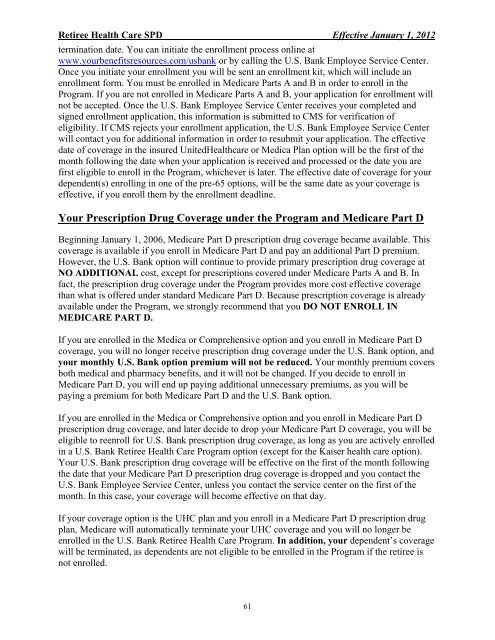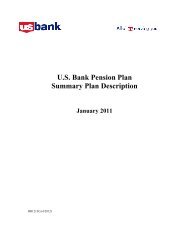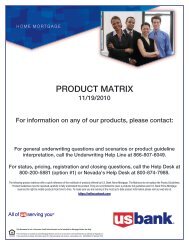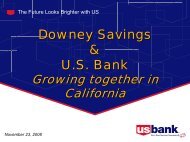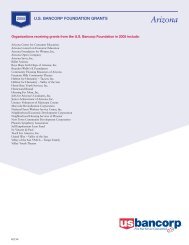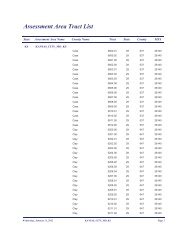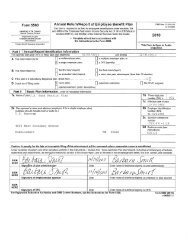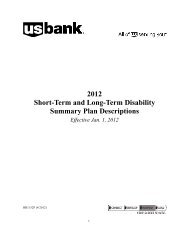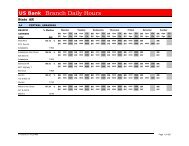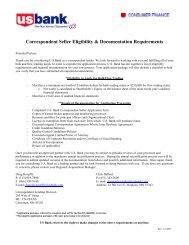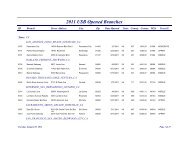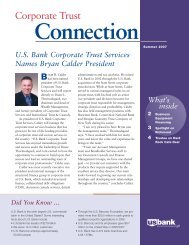The eligibility and enrollment rules for the U
The eligibility and enrollment rules for the U
The eligibility and enrollment rules for the U
Create successful ePaper yourself
Turn your PDF publications into a flip-book with our unique Google optimized e-Paper software.
Retiree Health Care SPD Effective January 1, 2012<br />
termination date. You can initiate <strong>the</strong> <strong>enrollment</strong> process online at<br />
www.yourbenefitsresources.com/usbank or by calling <strong>the</strong> U.S. Bank Employee Service Center.<br />
Once you initiate your <strong>enrollment</strong> you will be sent an <strong>enrollment</strong> kit, which will include an<br />
<strong>enrollment</strong> <strong>for</strong>m. You must be enrolled in Medicare Parts A <strong>and</strong> B in order to enroll in <strong>the</strong><br />
Program. If you are not enrolled in Medicare Parts A <strong>and</strong> B, your application <strong>for</strong> <strong>enrollment</strong> will<br />
not be accepted. Once <strong>the</strong> U.S. Bank Employee Service Center receives your completed <strong>and</strong><br />
signed <strong>enrollment</strong> application, this in<strong>for</strong>mation is submitted to CMS <strong>for</strong> verification of<br />
<strong>eligibility</strong>. If CMS rejects your <strong>enrollment</strong> application, <strong>the</strong> U.S. Bank Employee Service Center<br />
will contact you <strong>for</strong> additional in<strong>for</strong>mation in order to resubmit your application. <strong>The</strong> effective<br />
date of coverage in <strong>the</strong> insured UnitedHealthcare or Medica Plan option will be <strong>the</strong> first of <strong>the</strong><br />
month following <strong>the</strong> date when your application is received <strong>and</strong> processed or <strong>the</strong> date you are<br />
first eligible to enroll in <strong>the</strong> Program, whichever is later. <strong>The</strong> effective date of coverage <strong>for</strong> your<br />
dependent(s) enrolling in one of <strong>the</strong> pre-65 options, will be <strong>the</strong> same date as your coverage is<br />
effective, if you enroll <strong>the</strong>m by <strong>the</strong> <strong>enrollment</strong> deadline.<br />
Your Prescription Drug Coverage under <strong>the</strong> Program <strong>and</strong> Medicare Part D<br />
Beginning January 1, 2006, Medicare Part D prescription drug coverage became available. This<br />
coverage is available if you enroll in Medicare Part D <strong>and</strong> pay an additional Part D premium.<br />
However, <strong>the</strong> U.S. Bank option will continue to provide primary prescription drug coverage at<br />
NO ADDITIONAL cost, except <strong>for</strong> prescriptions covered under Medicare Parts A <strong>and</strong> B. In<br />
fact, <strong>the</strong> prescription drug coverage under <strong>the</strong> Program provides more cost effective coverage<br />
than what is offered under st<strong>and</strong>ard Medicare Part D. Because prescription coverage is already<br />
available under <strong>the</strong> Program, we strongly recommend that you DO NOT ENROLL IN<br />
MEDICARE PART D.<br />
If you are enrolled in <strong>the</strong> Medica or Comprehensive option <strong>and</strong> you enroll in Medicare Part D<br />
coverage, you will no longer receive prescription drug coverage under <strong>the</strong> U.S. Bank option, <strong>and</strong><br />
your monthly U.S. Bank option premium will not be reduced. Your monthly premium covers<br />
both medical <strong>and</strong> pharmacy benefits, <strong>and</strong> it will not be changed. If you decide to enroll in<br />
Medicare Part D, you will end up paying additional unnecessary premiums, as you will be<br />
paying a premium <strong>for</strong> both Medicare Part D <strong>and</strong> <strong>the</strong> U.S. Bank option.<br />
If you are enrolled in <strong>the</strong> Medica or Comprehensive option <strong>and</strong> you enroll in Medicare Part D<br />
prescription drug coverage, <strong>and</strong> later decide to drop your Medicare Part D coverage, you will be<br />
eligible to reenroll <strong>for</strong> U.S. Bank prescription drug coverage, as long as you are actively enrolled<br />
in a U.S. Bank Retiree Health Care Program option (except <strong>for</strong> <strong>the</strong> Kaiser health care option).<br />
Your U.S. Bank prescription drug coverage will be effective on <strong>the</strong> first of <strong>the</strong> month following<br />
<strong>the</strong> date that your Medicare Part D prescription drug coverage is dropped <strong>and</strong> you contact <strong>the</strong><br />
U.S. Bank Employee Service Center, unless you contact <strong>the</strong> service center on <strong>the</strong> first of <strong>the</strong><br />
month. In this case, your coverage will become effective on that day.<br />
If your coverage option is <strong>the</strong> UHC plan <strong>and</strong> you enroll in a Medicare Part D prescription drug<br />
plan, Medicare will automatically terminate your UHC coverage <strong>and</strong> you will no longer be<br />
enrolled in <strong>the</strong> U.S. Bank Retiree Health Care Program. In addition, your dependent’s coverage<br />
will be terminated, as dependents are not eligible to be enrolled in <strong>the</strong> Program if <strong>the</strong> retiree is<br />
not enrolled.<br />
61


